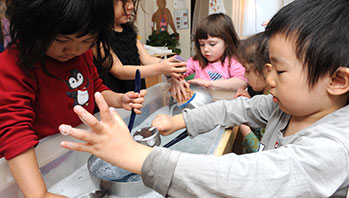- camera or cell phone with camera
- clipboard
- construction paper cut into strips
- paper
- paper clips
- ruler
- small stacking cubes
- string
- change
- grow
- measure
- ruler
MA Standards:
Language/L.PK.MA.6: Use words and phrases acquired through conversations, listening to books read aloud, activities, and play.
Mathematics/Measurement and Data/PK.MD.MA.1: Recognize the attributes of length, area, weight, and capacity of everyday objects using appropriate vocabulary (e.g., long, short, tall, heavy, light, big, small, wide, narrow)
Head Start Outcomes:
Logic and Reasoning/Reasoning and Problem Solving: Classifies, compares, and contrasts objects, events, and experiences.
Science Knowledge/Scientific Skills and Method: Observes and discusses common properties, differences, and comparisons among objects.
Science Knowledge/Scientific Skills and Method: Collects, describes, and records information through discussions, drawings, maps, and charts.
PreK Learning Guidelines:
English Language Arts/Language 2: Participate actively in discussions, listen to the ideas of others, and ask and answer relevant questions.
Mathematics/Measurement 14: Use nonstandard units to measure length, weight, and amount of content in familiar objects.
Explore Together (outdoors): Measuring Up

© Commonwealth of Massachusetts, Department of Early Education and Care (Jennifer Waddell photographer). All rights reserved.
STEM Key Concepts: There are many different types of plants; Many foods that animals, including humans, eat come from plants; We eat certain leaves, roots, fruits, and seeds
ELA Focus Skills: Compare and Contrast, Following Directions, Listening and Speaking, Measuring, Vocabulary
It’s time for children to revisit and review their plants. Take photographs to document children’s work during this exploration.
First, have children revisit their indoor plants.
- Have children check and measure their sprouts.
- Ask, What do you notice is happening in the water? (roots and sprouts are forming)
- If there are sprouts, use a ruler to measure one. Then say, Can you think of another way that I can measure this sprout? Discuss suggestions, then model using cubes, string, paper strips, and or paper clips to measure.
- Let children work in pairs or small groups to determine ways to measure a sprout.
Next, take children outdoors to see the beans, sunflowers, and any other plants they repotted or planted in the ground. Take the measuring tools and magnifying lenses along. If children still have the growth graphs they started several weeks ago, take those along for comparison purposes.
- Observe the plants. Ask, What plant parts can you see? Do you notice any new plant parts?
- Measure the plants. Help children cut paper strips or string to show height, or write for them how many “cubes tall” or “paper clips” tall each plant is.
- Talk about how the plants have grown. If you brought the graphs, have children compare the new measurements to the old.
Reflect and Share
Talk about what children discovered while checking and measuring plants. Share the pictures you took and have some plants, a ruler, and other measuring devices available so children can refer to them as they speak. Discuss the different measuring methods children used.
Social Emotional Tip: As children do the measuring activity, they learn to approach a task with flexibility, inventiveness, and imagination, and to demonstrate initiative by making independent choices.
Adaptation: Adapt the materials and procedures if younger children will be working in a group. You might prefer to have each young child do the activity individually, with one-to-one supervision.
